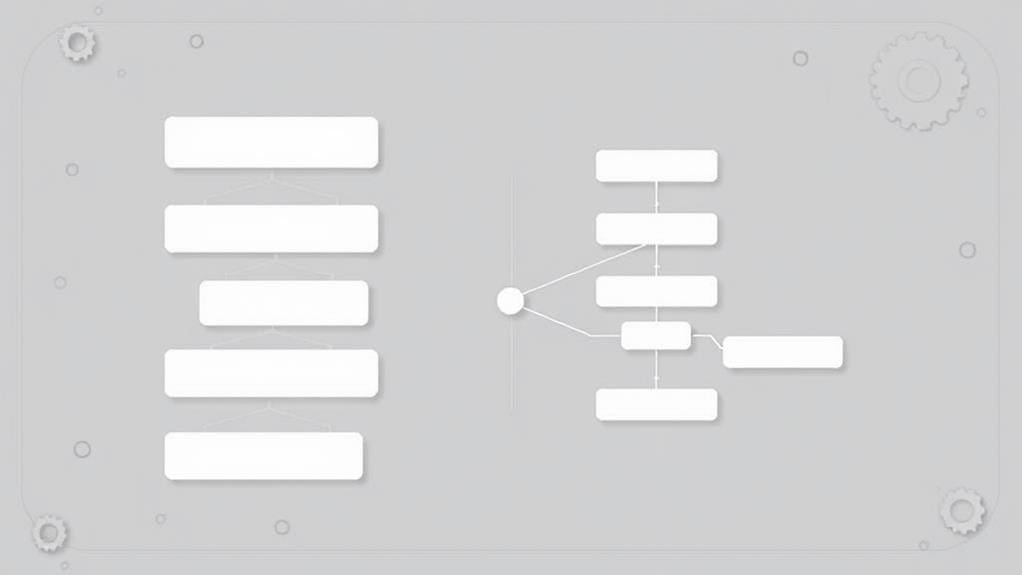You’re likely no stranger to the statistic that over 80% of businesses will be using chatbots by the end of this year. As a developer, you’re probably aware that creating a custom AI customer service solution can be a game-changer for your organization. But what sets a successful chatbot apart from a lackluster one? It all starts with DIY chatbot development, where you define the chatbot’s purpose and set clear objectives. By taking the reins, you can create a hybrid chatbot that combines rule-based and AI-powered capabilities – but what does this process entail, and where do you even begin?
Building a Winning Chatbot
Building a winning chatbot starts with defining its purpose, identifying business needs, and setting clear objectives. This direction is vital for development and deployment, as it determines the chatbot’s goals, such as providing first-level support or routing customer issues to representatives.
A hybrid approach to chatbot development can be more challenging to build, but it offers the best of both worlds, combining the strengths of rule-based and AI-powered chatbots.
To create a successful chatbot, it’s essential to track key metrics and KPIs such as goal completion rate (GCR) and customer satisfaction scores (CSAT) Chatbot Analytics. Effective chatbot development also involves creating software applications specifically designed to run on mobile devices.
To build a winning chatbot, you’ll need to choose a channel where customers are most active, such as a website or social media page. This certifies the chatbot reaches its target audience effectively.
You’ll also need to choose the right platform and tools for AI chatbot development, as it determines the level of customization and technical expertise required. By understanding user needs and behavior, you can make the AI chatbot user-centric and intuitive, involving simplistic navigation, easy prompts, and hassle-free transactions.
Leveraging advanced technologies like NLP and machine learning will also be vital for creating a conversational flow that provides instant replies, offers suggestions, and automates routine tasks.
Creating Conversational Architecture

When designing a conversational AI system, a well-crafted conversational architecture is crucial for organizing the flow of communication between the user and chatbot, guaranteeing a seamless and intuitive interaction experience.
As you build your conversational architecture, you’ll need to identify user intents, craft responses, and determine the conversation flow to address various user queries and scenarios.
A critical component of this architecture is the dialogue manager, which monitors the conversation flow and decides how to respond to user inputs, guaranteeing context-aware and personalized interactions.
To create an effective conversational architecture, you’ll need a deep understanding of your target audience, their pain points, and preferred communication channels, by analyzing the target audience’s communication styles, preferred tone, and language chatbot personality to design a chatbot that resonates with them.
By establishing a clear roadmap for the chatbot’s development, you can confirm it meets its intended purpose and provides value to users.
Visualizing the conversation flow will help you identify potential pain points, optimize the chatbot’s response strategy, and improve the overall customer experience.
By mapping conversation paths and handling exceptions, you can make your chatbot more receptive to changes in customer interaction, allowing it to adapt to different user inputs and scenarios.
A well-designed conversation flow should include simplistic navigation, easy prompts, and hassle-free transactions to provide a seamless user experience.
Crafting Answers and Dialogue
To create an engaging and effective chatbot, you’ll need to focus on crafting answers and dialogue that flow naturally and provide value to users. This involves designing conversational flows that mimic human-like interactions, using natural language processing (NLP) to understand user intent and respond accordingly.
| Dialogue Flow | User Intent | Chatbot Response |
|---|---|---|
| Greeting | Inquiry about product | Welcome! How can I assist you with our products? |
| Product Inquiry | Request for product info | Our product features [list features]. Would you like to know more? |
| Payment Inquiry | Request for payment options | We accept [list payment options]. Which one would you prefer? |
| Order Tracking | Request for order status | Your order is [status]. Would you like an update on the delivery time? |
| Support | Request for technical support | Sorry to hear that. Can you please describe the issue you’re experiencing? |
Implementing and Testing

Implementing a chatbot solution requires careful consideration of several key factors to guarantee flawless integration and peak performance.
You’ll need to choose a channel where your customers are most active, such as a website or social media page, to maximize engagement and reach.
By providing round-the-clock support, chatbots can verify that customer inquiries are addressed at any time, vital for businesses with global clientele or those operating outside regular hours 24/7 Support.
In addition, they handle multiple inquiries simultaneously, offering immediate answers to common questions and substantially reducing wait times.
When deploying your AI chatbot, integrating advanced technologies like Natural Language Processing (NLP) and machine learning techniques is vital to guarantee seamless interactions with users.
Testing is a critical step in the implementation process.
You’ll want to simulate user interactions to verify a holistic experience for your users and to identify potential issues before deployment.
Testing the chatbot with different scenarios and user inputs verifies accuracy and effectiveness.
Gathering user feedback is also essential to improve the accuracy and reliability of the AI chatbot, and to make necessary adjustments to the conversation flow.
By continuously testing and refining your chatbot, you can provide a more personalized and effective customer service experience, ultimately driving business success.
This iterative approach will help you fine-tune your chatbot to meet the evolving needs of your customers.
When implementing a chatbot solution, careful consideration of several key factors is essential to ensure seamless integration and optimal performance. Choosing the right channel for deployment is crucial, as it allows you to maximize engagement and reach by targeting the platform where your customers are most active, whether it’s a website, social media page, or messaging app. Providing round-the-clock support is another important aspect, as it ensures that customer inquiries are addressed at any time, which is especially vital for businesses with a global clientele or those operating outside regular hours. Chatbots are able to handle multiple inquiries simultaneously, providing immediate answers to common questions and significantly reducing wait times.
Integrating advanced technologies such as Natural Language Processing (NLP) and machine learning techniques is also crucial for ensuring seamless interactions with users. The implementation process should include thorough testing to simulate user interactions and identify potential issues before deployment. Testing the chatbot with different scenarios and user inputs verifies its accuracy and effectiveness, and gathering user feedback is essential for improving the AI chatbot’s accuracy and reliability.
Continuously testing and refining the chatbot allows for a more personalized and effective customer service experience, ultimately driving business success. This iterative approach helps fine-tune the chatbot to meet the evolving needs of customers, ensuring that it continues to provide value and meet the goals of the business.
Monitoring and Optimizing
Effective chatbot performance hinges on a data-driven approach, where continuous monitoring and analysis of key metrics play a pivotal role in identifying areas of improvement.
You’ll need to track KPIs like resolution rate, first response time, and customer satisfaction to gauge your chatbot’s performance. Chat data analysis is also essential, as it helps refine your chatbot’s knowledge base and scripts, ensuring it can effectively address customer queries and provide accurate responses.
To optimize your chatbot’s performance, leverage chatbot analytics tools, such as conversation flow analysis and sentiment analysis.
These tools provide actionable insights to improve your chatbot’s ability to resolve customer issues efficiently. Continuously monitor user interactions and feedback to identify areas of improvement and optimize your AI chatbot’s performance.
Regularly review chat history and customer feedback to identify common pain points and areas where your chatbot can be improved. By incorporating user feedback and chat data analysis, you can refine your chatbot’s conversation flow and enhance the overall customer experience.
This data-driven approach enables you to make informed decisions and drive continuous improvement in your chatbot’s performance.
An effective chatbot performance relies heavily on a data-driven approach, which involves continuous monitoring and analysis of key metrics to identify areas for improvement. Tracking KPIs such as resolution rate, first response time, and customer satisfaction is crucial for assessing the chatbot’s performance. Additionally, chat data analysis is essential for refining the chatbot’s knowledge base and scripts to ensure it can accurately address customer queries.
To optimize the chatbot’s performance, leveraging chatbot analytics tools like conversation flow analysis and sentiment analysis is recommended. These tools provide actionable insights to improve the chatbot’s ability to efficiently resolve customer issues. It is important to continuously monitor user interactions and feedback to identify areas for improvement and optimize the chatbot’s performance.
Regularly reviewing chat history and customer feedback enables the identification of common pain points and areas where the chatbot can be improved. By incorporating user feedback and chat data analysis, the chatbot’s conversation flow can be refined, ultimately enhancing the overall customer experience. This data-driven approach allows for informed decisions and continuous improvement in the chatbot’s performance.
Frequently Asked Questions
How to Build an AI Chatbot for Customer Service?
You’re about to discover the secret to 24/7 customer support – now, let’s plunge into building an AI chatbot. Identify its purpose, choose a development approach, and design conversational architecture to craft a personalized experience.
Can I Use Chatbot for Customer Service?
You can use chatbots for customer service to automate routine tasks, provide 24/7 support, and offer personalized experiences. They can handle FAQs, route complex issues to human agents, and integrate with CRM systems for enhanced customer support.
How Much Does It Cost to Develop an AI Chatbot?
Imagine you’re building a tower of AI capabilities; you’ll need a foundation budget of $5,000 to $50,000 or more, depending on complexity, technology, and features required for your AI chatbot development.
How Would You Design a Chatbot Service?
You’ll design a chatbot service by identifying its primary purpose, defining clear goals, and choosing the right platform and tools, then crafting conversational flows, structuring dialogues, and integrating with existing systems for seamless data transfer.
Conclusion
By following these steps, you’ll create a custom AI customer service solution that effectively addresses customer queries and provides personalized interactions. According to a recent study, companies that implement AI-powered chatbots see an average increase of 25% in customer satisfaction. As you continuously monitor and optimize your chatbot, you’ll be able to refine its performance and improve customer experience. With DIY chatbot development, you can tap into the full potential of AI-powered customer service and drive business growth.

